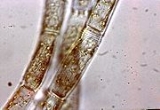
Oedogoniales
Encyclopedia
The Oedogoniales are an order
of filamentous freshwater green algae
of the class Chlorophyceae
. The order is well-defined and has several unique features, including asexual reproduction with zoospores that possess stephanokont flagella: numerous short flagella arranged in a subapical whorl. The oedogoniales have a highly specialized type of oogamy, and an elaborate method of cell division which results in the accumulation of apical caps.
The order comprises one family with three genera. Some common features among these genera may be obscure. The hairs of Bulbochaete and the heterotrichous system Oedocladium are similar to Chaetophorales, with which they may share a distant relationship. Of the genus Oedogonium there are over 330 species, about 70 species of Bulbochaete, and 10 species of Oedocladium. More than half of these species are known to North America. Many of the species are used by aquarium
owners.
Members of the order usually inhabit still waters such as lakes and ponds, rather than rivers and streams. The oedogoniales include free-living and epiphytic
members on other algae
or freshwater angiosperms.
Order (biology)
In scientific classification used in biology, the order is# a taxonomic rank used in the classification of organisms. Other well-known ranks are life, domain, kingdom, phylum, class, family, genus, and species, with order fitting in between class and family...
of filamentous freshwater green algae
Green algae
The green algae are the large group of algae from which the embryophytes emerged. As such, they form a paraphyletic group, although the group including both green algae and embryophytes is monophyletic...
of the class Chlorophyceae
Chlorophyceae
The Chlorophyceae are one of the classes of green algae, distinguished mainly on the basis of ultrastructural morphology. For example the chlorophycean CW clade, and chlorophycean DO clade, are defined by the arrangement of their flagella. Members of the CW clade have flagella that are displaced...
. The order is well-defined and has several unique features, including asexual reproduction with zoospores that possess stephanokont flagella: numerous short flagella arranged in a subapical whorl. The oedogoniales have a highly specialized type of oogamy, and an elaborate method of cell division which results in the accumulation of apical caps.
The order comprises one family with three genera. Some common features among these genera may be obscure. The hairs of Bulbochaete and the heterotrichous system Oedocladium are similar to Chaetophorales, with which they may share a distant relationship. Of the genus Oedogonium there are over 330 species, about 70 species of Bulbochaete, and 10 species of Oedocladium. More than half of these species are known to North America. Many of the species are used by aquarium
Aquarium
An aquarium is a vivarium consisting of at least one transparent side in which water-dwelling plants or animals are kept. Fishkeepers use aquaria to keep fish, invertebrates, amphibians, marine mammals, turtles, and aquatic plants...
owners.
Members of the order usually inhabit still waters such as lakes and ponds, rather than rivers and streams. The oedogoniales include free-living and epiphytic
Epiphyte
An epiphyte is a plant that grows upon another plant non-parasitically or sometimes upon some other object , derives its moisture and nutrients from the air and rain and sometimes from debris accumulating around it, and is found in the temperate zone and in the...
members on other algae
Algae
Algae are a large and diverse group of simple, typically autotrophic organisms, ranging from unicellular to multicellular forms, such as the giant kelps that grow to 65 meters in length. They are photosynthetic like plants, and "simple" because their tissues are not organized into the many...
or freshwater angiosperms.

